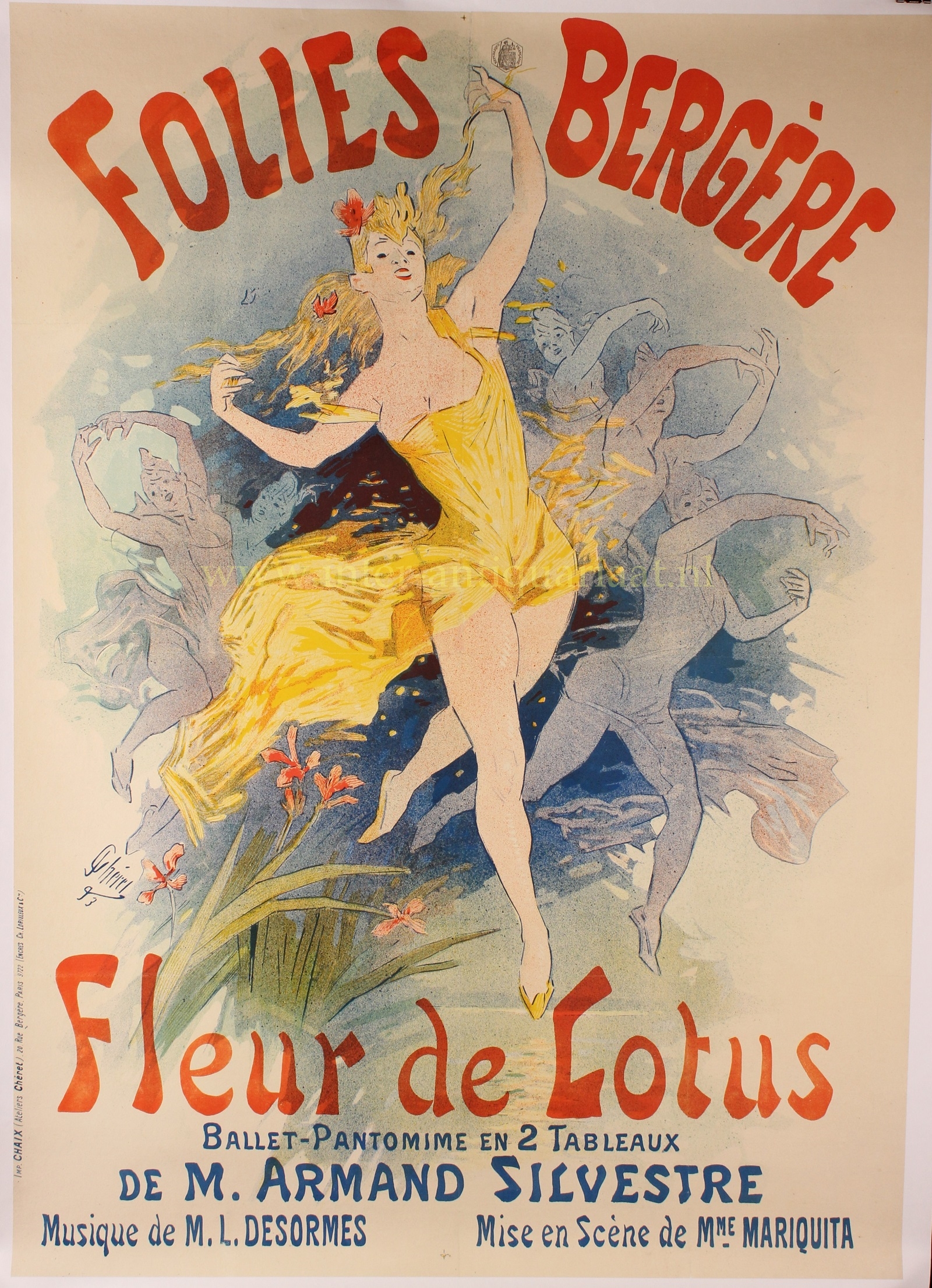Folies Bergère – Fleur de Lotus – Jules Chéret, 1893
Advertising poster “Folies Bergère, Fleur de Lotus”, colour lithograph designed by Jules Chéret (1836-1932), printed by Chaix in Paris in…
Read more
Advertising poster “Folies Bergère, Fleur de Lotus”, colour lithograph designed by Jules Chéret (1836-1932), printed by Chaix in Paris in 1893. Backed with linen. Size: approx. 124 x 88 cm.
Opened in 1869, the Folies Bergère theatre emerged straight to being the most exciting place in 1870s Paris. As one of the first establishments extensively equipped with electric chandeliers, at the time it was a paragon of modernity, quite different than the many Parisian café-chantants. In 1882 it was meanwhile considered as the temple of the ‘joie de vivre’, where entertainment was combined with a food and drink. Visitors were not only from the upper- but also from the French middle class, which experienced its heyday during that period.
Jules Édouard Marchand, the artistic director of the Folies Bergère, hired the most famous actors of the time with great success. Marchand conceived a new kind of show, the music-hall revue with women at the heart of the programme, singing and dancing with comedy interludes. The name Folies Bergère evokes the feeling of the Paris of the Belle Époque like no other establishment.
This 1893 poster announces ‘Fleur de Lotus’, a ballet-pantomime by Armand Silvestre to music by M.L. Desorment.
Fleur the Lotus tells the story of two Indian peasant girls, Goutte de Rosée and her sister Fleur de Lotus, who are discovered by a Prince and his friend. The ballet follows a basic Cinderella plot – an entire scene is devoted to Goutte de Rosée’s acquisition of a beautiful dress and consequent transformation into a princess- but with variants that parody the conventions of pantomime-ballets staged by the Opéra. The ballet begins with Fleur de Lotus instructing her sister on how to avoid the unwanted attention of passing gallants: she is to cover her face with soot and dress in old rags to appear undesirable. Goutte de Rosée, left alone in their rustic hut while her sister is taking their goat to pasture, hears a royal cortège approaching and covers her face as instructed. A young gallant – the prince’s friend- enters the stage, finds the hut and peers through a crack in the door. Seeing Goutte de Rosée and suspecting her ruse, he throws water in her face to reveal her beauty. He falls in love, but the Prince enters and he too, falls in love with Goutte de Rosée. The Prince proposes marriage, and a couple of scenes later and an enamoured Goutte de Rosée follows him to the palace. Fleur de Lotus returns, finds a trail of grains left along the path by Goutte de Rosée, sets out to search for her sister, gets waylaid by water nymphs, bathes in a lake, eventually finds her sister and becomes engaged to the prince’s friend. The scenario could be read by any member of the audience as a conventional romantic comedy with references to Cinderella and Tom Thumb. For those familiar with Romantic repertoire however, Fleur de Lotus might also have come across as an exotic retelling of Giselle with a few sexy interludes and a fairy-tale ending.
Jules Chéret (1836-1932) was the first to create colour posters, vibrant designs for cabaret, variety and theater such as Olympia, Folies Bergères and Moulin Rouge. Later he expanded his work to create advertisements for all kinds of products. He is seen as the father of modern lithography and advertising posters.
Focusing on image rather than text, Chéret revolutionized the way posters were designed. He believed that a poster should not necessarily show a product, it was merely important that it generated a positive reaction from the viewer.
With his large posters depicting free-thinking ladies, he instigated the emancipation of women. Before Chéret, women were usually depicted either as prostitutes, or as Puritan. His so-called ‘Chrérettes’ were neither. It was noticeably liberating for the women of Paris, who were now allowed to wear décolletage and smoke in public.
Today, Chéret is one of the most collected artists of the Belle Époque.
This is one of the last posters Chéret designed for the Folies Bergére and it is also one of the most graceful. A showgirl, like all of Cheret’s models always smiling, sometimes a little giggly, often disheveled by the steps of the dance, in a diaphonous yellow dress, dances beside orange flowers, which also appear in her hair. In the background, the rest of the chorus line appears in blue silhouette. Chéret made a spectacularly exuberant design, a masterpiece of graceful motion and pure joy.
Price: SOLD

